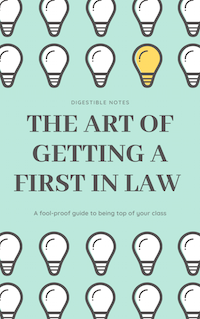Basic Criminal Damage
Definition
⇒ Section 1 of the Criminal Damages Act 1971 defines criminal damage.
⇒ The actus reus is the destruction of or damage to property belonging to another without lawful excuse.
⇒ The mens rea is that the defednat intended or was reckless (a) that his or her action would damage r destroy property and (b) that that property belonged to another.
⇒ The maximum punishment is ten years' imprisonment.
Damage
⇒ The statute uses the term 'destroy or damage'.
⇒ The term 'destruction' indicates that following the acts of the defendant the item no longer exists. The term 'damage' therefore suggests that the acts have affected the property, but fall short of destruction.
⇒ The idea of damage involves either:
- a reduction in the value of the item; or
- a reduction in the usefulness of the item.
⇒ There are a few issues on the meaning of damage over which there is some dispute:
- Is minimal damage excluded from the concept? See the case of A (A Juvenile) v R [1978], for example.
- Is adding to property damaging it? See the case of Lloyd v DPP [1992], for example, it was held that putting a wheel clamp on a car did not constitute criminal damage because it did not affect the integrity of the car.
The Art of Getting a First in Law - ONLY £4.99
FOOL-PROOF methods of obtaining top grades
SECRETS your professors won't tell you and your peers don't know
INSIDER TIPS and tricks so you can spend less time studying and land the perfect job
We work really hard to provide you with incredible law notes for free...
The proceeds of this eBook helps us to run the site and keep the service FREE!

Property
⇒ Section 10 of the Criminal Damages Act 1971 defines property.
1. 'Property' means property of a tangible nature, whether real or personal, including money and -
- including wild creatures which have been tamed or are ordinarily kept in captivity, and any other wild creatures or their carcasses if, but only if, they have been reduced into possession which has not been lost or abandoned or are in the course of being reduced into possession; but
- not including mushrooms growing wild on any land or flowers, fruit or foliage of a plant growing wild on any land.
⇒ For the purposes of this subsection 'mushrooms' includes any fungus and 'plant' includes any shrub or tree.
⇒ The notion of property here is very similar to the notion of property in theft. However property does not have the same meaning in both offences.
- For example, land can be damaged (e.g. pollution), even though it cannot be stolen. By contrast intangible property, such as patents and copyrights, can be stolen, but not damaged.
Belonging to another
⇒ The Act makes it quite clear that it is an offence under section 1 only to damage property which 'belongs to another'
- However, it is an offence to damage your own property if the offences is one contrary to section 1(2) of the Criminal Damages Act 1971 (see the topic notes on aggravated damages).
⇒ Under section 10 of the Criminal Damages Act 1971, property shall be treated as belonging to any person -
- having the custody or control of it;
- having in it any proprietary right or interest (not being an equitable interest arising only from an agreement to transfer or grant an interest); or
- habving a charge on it
⇒ Where property is subject to a trust, the persons to whom it belongs shall be so treated as including any person having a right to enforce the trust.
Mens Rea
⇒ The mens rea for the offence is set out in section 1(1) of the Criminal Damages Act 1971: it must be shown that the defendant intended or was reckless as to the damaging of property.
⇒ See the topic notes on recklessness. It requires proof that the defendant foresaw that his or her act would damage property and it is a subjective test.
⇒ It should be noted that the mens rea applies to the damage and the fact that it belongs to another.
- This is most relevant in relation to intentional damage: a person who intentionally damages property believing it to be their own does not thereby intentionally damage property belonging to another.
Defences
⇒ In addition to the general defences (e.g. duress - see the topic notes on these general defences) there are some specific defences to criminal damage found in the Act. In section 5 of the Criminal Damages Act 1971 a defendant has lawful excuse:
- if at the time of the act or acts alleged to constitute the offence he believed that the person or persons whom he believed to be entitled to consent to the destruction of or damage to the property in question had so consented, or would have so consented to it if he or they had known of the destruction or damage and its circumstances; or
- if he destroyed or damaged or threatened to destroy or damage the property in question or, in the case of a charge of an offence under section 3 above, intended to use or cause or permit the use of something to destroy or damage it, in order to protect property belonging to himself or another or a right or interest in property which was or which he believed to be vested in himself or another, and at the time of the act or acts alleged to constitute the offence he believed—
- that the property, right or interest was in immediate need of protection; and
- that the means of protection adopted or proposed to be adopted were or would be reasonable having regard to all the circumstances.
⇒ For the purposes of this section it is immaterial whether a belief is justified or not if it is honestly held.
⇒ In brief, there is a defence for a defendant who honestly believes that the victim was consenting or would consent to the damage. It is also a defence to damage property in order to proptect your own or another's property.
- It is enough if you act because you believe that you were protecting the property, even if in fact your property was not at risk or was not your own.
- However, subsection (2)(b)(i) stresses that it must be shown that the defendant believed that property as in immediate need of protection and subsection (2)(b)(ii) that the protection would be reasonable in all the circumstances.
⇒ See the case of R v Hill and Hall (1989).
- The decision is controversial because it takes a very narrow interpretation of 'acting in order to protect property'.
- Rather than seeing this test as being about the motive of the defendant (which might be thought to be the natural meaning of the words) the court interpreted it to be asking whether objectively (but on the facts as understood by the defendant) the act could be said to cause the protection of property.
Law Application Masterclass - ONLY £9.99
Learn how to effortlessly land vacation schemes, training contracts, and pupillages by making your law applications awesome. This eBook is constructed by lawyers and recruiters from the world's leading law firms and barristers' chambers.
✅ 60+ page eBook
✅ Research Methods, Success Secrets, Tips, Tricks, and more!
✅ Help keep Digestible Notes FREE

